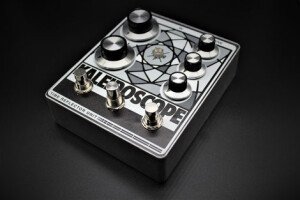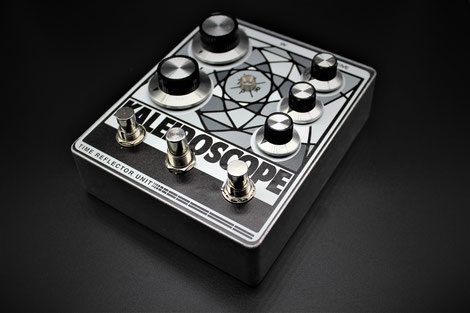Not satisfied with those reviews?
Filter
Our members also liked:
5.0/5(1 reviews)
100 %
Write a user review
Users reviews
 MGR/Brian Johnston
MGR/Brian JohnstonCold, Shimmering and Haunting best describes this Reverb
Published on 05/07/19 at 04:49SOUND:
JPTR FX’s Kaleidoscope is glassy, cold and haunting. There is something very distinct about this reverb that I have not heard in other reverbs, and so if you prefer a warm reverb the Kaleidoscope is not for you.
However, if you want a reverb that allows you to see your frosty breath as you play then consider the Kaleidoscope. The demo video accompanying this review makes the Kaleidoscope’s sound obvious, but another good descriptor is that the reverb sound is icy and somewhat industrial – yet not harsh or shrill. There are some nice ‘tone’ features with this pedal, besides its frigid sound,…Read moreSOUND:
JPTR FX’s Kaleidoscope is glassy, cold and haunting. There is something very distinct about this reverb that I have not heard in other reverbs, and so if you prefer a warm reverb the Kaleidoscope is not for you.
However, if you want a reverb that allows you to see your frosty breath as you play then consider the Kaleidoscope. The demo video accompanying this review makes the Kaleidoscope’s sound obvious, but another good descriptor is that the reverb sound is icy and somewhat industrial – yet not harsh or shrill. There are some nice ‘tone’ features with this pedal, besides its frigid sound, including Feedback, which gives a resonating effect that can be a slight shimmer to a nasty reverberation that is suitable for an outer-space horror movie. The degree of this feature is relative to the Reverb knob (how deep you want the reverb) – the more Reverb the more prominent the Feedback. The Swell knob determines how quickly the Reverb reaches full bloom. The Gain & Compression knob increases both aspects as you turn it up, to the point that you get some white noise-type distortion mixed into the Reverb (besides increasing volume and modest compression). And if you want nothing but Reverb, for a volume pedal or synth-type effect, just click on the Kill switch and you get nothing but wet… and if you want to disengage the Kaleidoscope then the Bypass switch will do the trick.
OVERALL IMPRESSION:
At 199 Euro the Kaleidoscope is pricey enough, but it stands out as a very unique contribution to strange and ambient music. The Kaleidoscope has a beautiful eeriness to its tone – cold, icy and industrial. The Feedback produces modest to intense shimmering and modulation that can sound subtle when turned low to robust in how it builds tension in what you play, or as JPTR FX suggests “in a liquid swirl of overtones.” The Gain/Compressor works very well in adding both volume and boldness in the tone, but also creates white-noise fuzz that adds a unique character to the Reverb without touching your guitar’s tone (it needs to be turned up quite a bit for this to occur). Its hardcore look, built one at a time in Germany, is something reminiscent of a 1950s mad scientist laboratory control box and while being ideal for many instruments – guitar, drums, synth and even vocals. Combined with an acoustic guitar you can produce some of the loneliest sounding music, as though sitting and playing in a large abandoned factory. The sounds from the Kaleidoscope become even more ambient and ethereal when Killing the dry signal – tones that seem to float in the air. The Kaleidoscope truly is a ‘Time Reflector Unit.’
GENERAL USE:
Some coordination of the controls is required since once aspect can affect another. The Master Volume obviously controls how loud the signal is, but as you increase the Gain/Compression you will need to adjust the Master Volume. Likewise, a little Feedback goes a long way when the Reverb is very high (sounding very cavernous), whereas you can increase the Feedback as the Reverb reduces (down to ‘room’ level type reverb). The Feedback produces a shimmer to the Reverb sound, but it’s not like a typical shimmer you hear with reverb pedals (e.g., a crystal shimmer)… it can be subtle, but when turned up it produces more of a throbbing or pulsating shimmer modulation that becomes very dramatic in the background (and even overpowering if preferred and dialed in as such). The Swell knob is the most subtle of the bunch and it controls how quickly or slowly the Reverb blossoms toward its ultimate conclusion. There are three switches and since they are close together it may be prudent to add a Barefoot Button Tall Boy to the middle switch, which is a control that Holds or freezes the reverb – a fantastic feature if you enjoy drone-like background tones while playing overtop. The two outside switches including Kill, which removes the dry signal so that you have nothing but wet reverb, whereas the other footswitch Bypasses the Kaleidoscope so there is no reverb. Both Kill and Bypass have their own LED lights to indicate on and off.
OTHER DETAILS:
A medium sized pedal made of heavy duty, lightweight aluminum with a very industrial looking graphics and knobs, the Kaleidoscope may be considered an ‘Ugly Sound Device,’ at least according to JPTR FX, but I think it looks both unique and modern hardcore. Measuring 140 mm (L) x 120mm (W) x 40mm (H – excluding knobs) (5.5 x 4.7 x 1.57 inches), there are three footswitches. The Kill and Bypass switches are hard switches that produce a solid click when pressed. The middle footswitch (Hold) is a soft-switch, which means it does not ‘click’ when engaged or disengaged. The five knobs may be plastic, but they could very well be aluminum based on the feel and looks (they remind me of the old television sets from the 1970s). All five knobs have good quality pots (smooth and solid when turned). The cable input, cable output and power input are located in the back, which saves pedalboard space, but also prevents accidental stepping and damage when stomping. The two LEDs (that indicate when the Kill or Bypass switches are initiated) have bevels around them, both located at the top of the pedal. The Kaleidoscope does not work on batteries and requires a standard 9VDC (center -) power supply, while consuming 100mA of power.See less00






